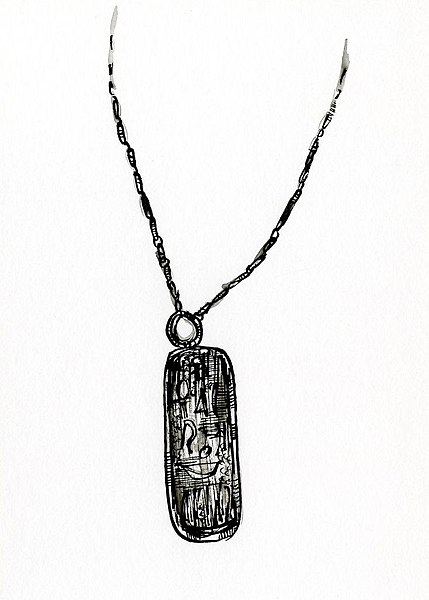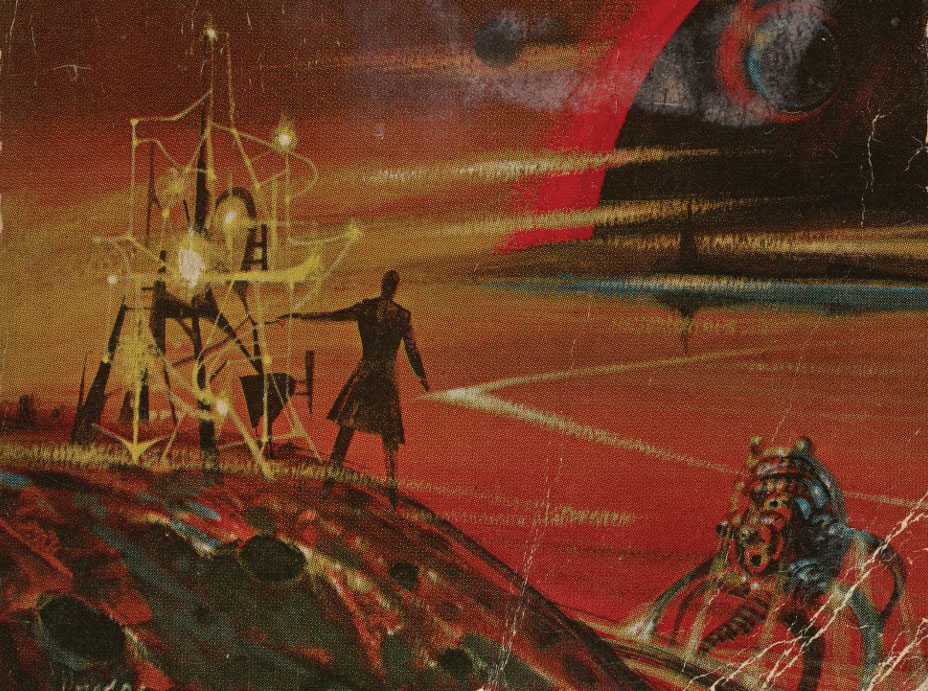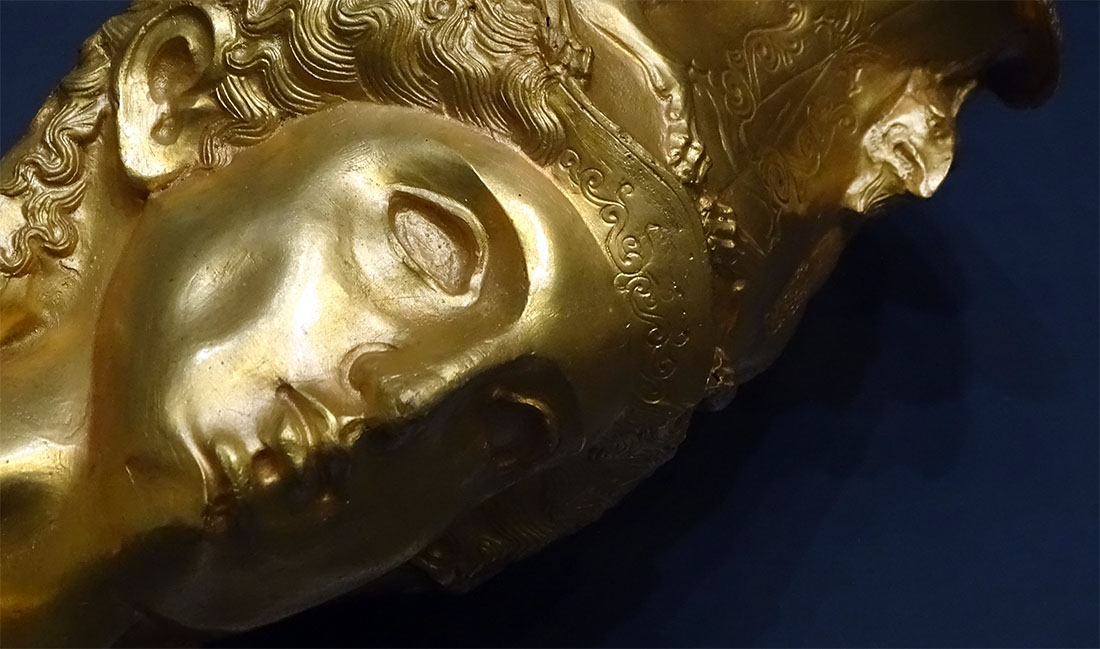See Part 1 to determine if a room has treasure and what type of treasure it contains, then roll on these tables.
GOLD
| LEVEL | GOLD |
|---|---|
| 1st / 2nd Level | 1d6 x 100 GP |
| 3rd / 4th Level | 1d6 x 500 GP |
| 5th / 6th Level | 1d6 x 1000 GP |
POTIONS & AMULETS
(1d6: Potion 1-5, Amulet 6)
| 2D6 | POTION/AMULET |
|---|---|
| 2 | Shape Changing (Polymorph Self) |
| 3 | ESP or X-Ray Vision |
| 4 | Longevity |
| 5 | Flying |
| 6 | Giant Strength |
| 7 | Sustenance |
| 8 | Speed |
| 9 | Heroism |
| 10 | Control (Animals 1-2, Human 3-4, Giant 5-6) |
| 11 | Invisibility |
| 12 | Teleportation |
Potions: Alchemical, liquid transmuted by technomantic process, or nano-particles in a liquid suspension.
 Amulets: Amulets either harness and imprison minor demons, feyish spirits, or some other powerful entity. Or they are ancient technomantic artifacts; the enduring technology which serves as a template for the cheap, modern “spell eggs” (see below). 1d50 charges. The former either expend or release their trapped spirit; the latter can be recharged with battery power.
Amulets: Amulets either harness and imprison minor demons, feyish spirits, or some other powerful entity. Or they are ancient technomantic artifacts; the enduring technology which serves as a template for the cheap, modern “spell eggs” (see below). 1d50 charges. The former either expend or release their trapped spirit; the latter can be recharged with battery power.
SPECIFIC ENTRIES
Heroism: 10% chance the effect of the potion is permanent, but works by replacing the current version of the character with one from an alternate future/dimension. Amulet’s effect lasts for as long as it is worn, expending 1 charge per day.
Sustenance: Drinking the potion renders it unnecessary for the drinker to imbibe food or water for a month and a day. The amulet works like a create food spell.
ARMS & ARMOR

| 2D6 | ARMS & ARMOR |
|---|---|
| 2 | Lightning Bolt Thrower (Laser) |
| 3 | Blue Armor |
| 4 | Armor or Shield +2 |
| 5 | Armor or Shield +1 |
| 6-8 | Magic Sword |
| 9 | Bow +1 |
| 10 | Bow +2 |
| 11 | Magic Arrows |
| 12 | Fireball Thrower |
Blue Armor: This armor is formed from an extraordinarily light blue metal. The greaves each have a panel of multi-colored buttons, but these only work when the armor is fully assembled (as per a lightning bolt thrower, a fireball thrower, and 1d3 random pieces of Equipment.) When generated, determine which piece is present randomly:
| D6 | BLUE ARMOR |
|---|---|
| 1 | Helmet |
| 2 | Breastplate |
| 3 | Vambrace |
| 4 | Greaves |
| 5 | Gauntlets |
| 6 | Roll Again Twice (stacks) |
Each additional piece of armor adds a +1 bonus to AC. (Thus a complete suit is +5 armor.) However, when a complete suit is worn the onboard AI activates and takes control of the suit. (Those wearing the suit can sometimes be heard screaming, “Let me out! No! Stop!”)
Fireball Thrower: 1d100 charges. 6th level fireball.
Lightning Bolt Thrower (Laser): 1d100 charges. 6th level lightning bolt.
EQUIPMENT
| 3D6 | EQUIPMENT |
|---|---|
| 3 | Transporter 1-4, Dimensional Transporter 5-6 |
| 4 | Battery Power 1-4, Generator 5-6 |
| 5 | Medical Unit |
| 6 | Communicator |
| 7 | Skimmer 1-3, Flyer 4-5, Borer 6 |
| 8 | Crystal Ball |
| 9 | Spell - Formula 1-3, Egg 4-6 |
| 10 | Storehouse of Normal Items (roll GP value) |
| 11 | Ancient Books, Manuscripts, and Maps (roll on sub-table) |
| 12 | Triorder |
| 13 | Mount (Super Horse 1, Worg 2, Unicorn 3, Clockwork 4, Roc/Tarn 5-6) |
| 14 | Illusion Projector |
| 15 | Screener |
| 16 | Mercurial Water |
| 17 | Robot 1-5, Controller 6 |
| 18 | Time Machine |
| D6 | ANCIENT BOOKS, MANUSCRIPTS, AND MAPS |
|---|---|
| 1 | Technical Manuals |
| 2-4 | Maps (General 1-3, Treasure-Gold 4, Treasure-Equipment 5, Treasure-Magic 6) |
| 5 | Educator |
| 6 | Entertainer |
| D6 | ROBOTS |
|---|---|
| 1-2 | Fighting Machine |
| 3 | Water Machine |
| 4 | Flying Machine |
| 5 | Teleportation Machine |
| 6 | Humaniform |
Battery Power: A battery of the ancients. They can be used to recharge technological items of the ancients.
- Generator: Generators are large, generally immovable facilities that create energy. This energy may be harvested from the environment by comprehensible means (geothermic, solar, etc.); or it may be based on incomprehensible technology (space-time crystals, etheric harvesting, etc.). Generators can be used to recharge batteries. 10% of generators can also create one dose of mercurial water per week.
Borer: 1d100 charges, 1 charge per hour of use. Can dig through ten yards of any material every hour. Makes a hole 10’ x 10’ as it goes. It has no weight but can only move about 1 mph.
Communicator: 10% chance it is found with a paired device.
Crystal Ball: Per OD&D. Images displayed looking like they’re composed from “ragged lines” (like a holographic CRT display).
Flyer: A lightweight vehicle of the ancients that can be folded up to relatively compact dimensions. As per broom of flying (50%), flying carpet (40%), or a flying carpet that can carry up to 12 people (10%).
Illusion Projector: 1d100 charges. Can create the 3D image of anything and animate that image. Range is line of sight, no limit, and image must be less than 100 yards on a side.
Medical Unit: Coffin-sized unit. Will heal all wounds in 24 hours, but there’s no way to get out early. 1% chance per person healed that the unit loses power.
Mercurial Water: Silvery liquid. Can be used to refuel robots, skimmers, time machines, and other vehicles of the ancients.
Screener: 1d100 charges. Creates spherical sphere of energy. Cuts out all outside light, magic, etc. Those within the barrier are behind the equivalent of +5 Armor. Magic cannot pass the barrier. Lasts 10 minutes per charge. 5% chance it malfunctions and cannot be lowered manually (staying up until the current charge runs out).
Skimmer: A lightweight vehicle of the ancients that can be folded up to relatively compact dimensions. Can cross stretches of water at great speed, 50 mph and greater, as well as marsh and short (10 yards) stretches of low unobstructed land. Hitting a snag will wreck the Skimmer and cause the occupant one Hit Die in damage per 5 mph of speed. Chance of hitting a snag is about 1% per 100 miles of water, 5% in marsh, and 5% everytime any land is crossed. All encounter chances can be ignored due to its speed.
Spell Egg: Technomantic, clockwork devices. Modern spell-eggs are inferior to those of the ancients (which are classified as amulets), and are one-use only items.
Note: Ancient manufacturing facilities known as Laboratories crank out spell eggs (the Egg of Coot controls one). Newer facilities, seeking to reverse engineer the Laboratories, are known as Workshops (the Ran of Ah Fooh has created one).
Spell Formula: These are plans which allow one to make spell eggs. The arcane arts are based on figuring out how to adapt the details of these plans (most of which are reverse-engineered from amulets) so that they can be performed as magic rites (i.e., spells). So one trained in the arcane arts can also use these formula to either make spell eggs (the equivalent of scrolls) or learn the spells (customizing rites into their spellbooks).
Time Machine: See Robots.

Transporter: These are large, generally immovable facilities, similar to a Star Trek transporter pad. One can use the equipment to transport somewhere else. If one has access to a crystal ball or similar distance viewer, they might also be able to transport people to the pad. 1% chance per person transported that the facility loses power.
- Dimensional Transporter: Dimensional transporters work the same, but can also access locations in other dimensions. Each dimensional transporter generally only has 1d6 such dimensions currently accessible, although it may be possible to load additional dimensional tables into them.
Tricorder: 1d100 charges. Will give the operator complete physical information about any item it is pointed at. Has a range of 100 yards, only metal will block its effect. Will only give out information that it is specifically asked for. When asked general questions, there is a 25% chance it can be found in its limited databanks.
ANCIENT BOOKS, MANUSCRIPTS, AND MAPS
Educator: Teaches you how to use the mechanical marvels of the ancients. One tape in the machine, other tapes can be used as treasure finds, etc.
Entertainer: Any jolly you ever wanted, and some that might kill you. User loses track of time and is open to attack. Roll 1d10 for hours of use. Cures all fatigue and raises fighting level by one for the rest of the day.
Technical Manual: Describes the function and use of Ancient technology.
ROBOTS
- Base Stats: 1d6 AC, 1d6 HD; there is a 10% chance that any robot is a lightning thrower (20 bolts, 6d6 damage).
- Controllers: Allows players to get Robots to do what the player wants. Otherwise, there is only a 20% chance you can use the Robot, 20% chance it is defective, 60% that it is hostile.
- Size (1d6): Small 1-3, Medium 4-5, Large 6
- Small: Autonomous unit. Roughly human in size.
- Medium: Capable of being piloted (requires training/educator) by a single passenger.
- Large: Capable of carrying 3-18 passengers.
- The fact the larger sizes can operate as vehicles is not immediately apparent.
Fighting Machine: A tripod combat platform. +2 HD.
Flying Machine: A hovering droplet of liquid silver metal with a rippling, ridged, perfectly reflective surface.
Humaniform: A humanoid robot or android. Some are quite lifelike in their simulation of humanity (or other species).
Teleportation Machine: Generally tripod robots, although humaniform variants have been reported. These entities can, upon request, teleport you and/or themselves to a location of your desire. (Or use the same function as a devastating offensive capability and/or means of flight.)
Time Machine: Roll a d6 to determine the type of temporal manipulation the machine is capable of. The machine’s power requirements are quite severe, however, requiring mercurial fluid for each temporal manipulation.
- 1, 2, 3: Stopping time for 1d6 rounds, during which time it can take actions.
- 4, 5: Travel forward through time, reappearing in the same spot at a later time of their choosing.
- 6: A true time machine, a la H.G. Wells. Its incredibly convoluted control schema, however, requires a save vs. spells. On a failure, the character has inadvertently (and irrevocably) shunted themselves into an alternate timeline.
Water Machine: Amphibious robots that operate freely in water. Some take the form of articulated, modular robotic sea serpents.
DESIGN NOTES
As far as treasure generation is concerned, there is some evidence that Arneson originally used a point budget to stock treasure, too. Or, at least, magical treasure. Unfortunately, as far as I can tell, no details of this system are available. The method developed here is based on the basic methodology found in Volume 3 of OD&D, using additional methodology inspired from the incomplete Loch Gloomen and Bleakwood stocking tables, and original magic tables stocked with Arneson’s science fantasy items and his magic swords.
Most of the items found here originate specifically from Arneson (with a few exceptions, such as mercurial water). I have made a number of entries much more specific in their description, however, reflecting my personal creative impulse. (For one example of this in practice, see Arneson’s Machines.) I have also added a number of specific mechanics for items, perhaps the trickiest of which was the Time Machine (which I thought about eliminating entirely due to the self-evident difficulties such a device would create in actual play… before deciding, “Fuck it, let’s go for it and see what might happen.”)
What I consider the most important thing to grok about the Blackmoor setting is that it is post-apocalyptic and much of its “magic” is actually super-science technology. You can see that reflected in the treasure tables here and, if anything, I’ve leaned even more heavily into this concept. I find it interesting, but also perhaps unfortunate, that every iteration of Blackmoor seems to have stripped away more and more of this unique character, leaving behind an increasingly generic D&D milieu.
My personal vision is that there is a source or cache of ancient technology deep beneath Castle Blackmoor. There is also, as established by Arneson, a “gate to Hades”. (These may be one and the same thing, but, at least for myself, I think not.) As the forces of Evil migrate up through the dungeon, they bring the Ancient technology with them, making its secrets available to the world above. It also means the further down you go into the dungeons, the more they become a technomantic, super-science complex.
The other thing I love about Arneson’s items list is how many of them unlock new game play (rather than just enhancing the existing cycle of play). When you get a dimensional transporter, the game is going some place it hasn’t before. If you get your hands on a borer, your whole relationship to the campaign changes. (I’m assuming that’s how the original Blackmoor players ended up constructing the Orcian Way, a tunnel straight from the first level of the dungeon the tenth.)
Other notes…
What about silver pieces and copper pieces? I found no evidence in the First Fantasy Campaign that Arneson was using either prior to D&D.
My vision of amulets and spell eggs is an example of leaning into Arneson’s science fantasy. When Arneson spoke of “manufacturing spells”, he was almost certainly just talking about “formula scrolls”, but I follow my inspiration here. Same thing with the nano-particle potions.













I knew nothing of Blackmoor before these write-ups, so I’m enjoying them. One quick note:
You write: “What about silver pieces and copper pieces? I found no evidence in the First Fantasy Campaign that Arneson was using either prior to D&D.”
But copper coins may have appeared in Blackmoor: Greg Svenson states in his write-up: “After wandering more corridors we entered a room where we were attacked by giant spiders. Another fierce battle ensued and we overcame them, losing a couple of men in the process. We found some copper coins and broken weapons in the room along with a bunch of bones, including human bones.”
Perhaps copper coins were too worthless to bother measuring or using in game play, and were just relegated to set dressing? It seems likely that Arneson wouldn’t have included charts for them in his notes if they were not significant. But also appears they existed?
Great stuff. The spell eggs are an interesting idea – you could justifiably use EPT eyes for these.
The Orchian way actually only goes to level 6 – the original bottom and orc lair.
No, no copper coins in Blackmoor. No magic rings either.
Justin, I think I would love to play in your game!
This is great stuff and I’m enjoying the series. Thank you, as always, for the inspiring content. 😀
You might want to do something about how the screener creates a “spherical sphere of energy,” though.
Hmm… What do you think of “spherical sphere of spheroidal energy”?
“Spell eggs” remind me of an anecdote I heard from early D&D – where a group of players concluded from the existence of “fire balls” that all spells must be magical balls that magic-users owned and would throw at their enemies, and which would explode into various spell effects on impact.
Sadly, the existence of Fireball and the various “X Sphere” spells makes this story impossible to Google, so I can’t find the source again.